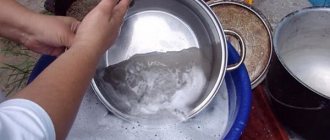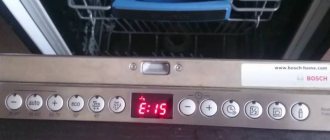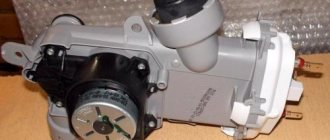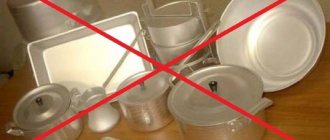How to care for your dishwasher?
To extend the life of a household appliance, you need to learn how to properly care for it. The user must constantly clean the filter elements from accumulated debris, as well as rinse the basket, remove scale and rust.
Every 20 rinsing cycles, the unit is washed with a degreaser or citric acid, and significant deposits are removed manually. Do not leave blockages inside the household appliance; dirt accumulations are removed using a thin wire bent with a hook.
You can remove mold using bleach, but this product is not recommended for use on equipment whose drum is made of stainless steel. A similar treatment is done without adding dishes at low speeds for 10 minutes. Rust on a household appliance is treated with sealant or coated with paint.
A well-maintained car means clean dishes.
Various stains inevitably appear even if the machine itself is not working properly. The following factors may be the cause of the failure:
- Dirt accumulated inside the dishwasher. To get rid of it, just start the washing mode without dishes, using special cleaning products. For the same purpose, you can use regular citric acid.
- Calcified deposits on cutlery often indicate clogged filters. In such cases, they need to be replaced or cleaned.
- If you use the machine strictly according to the instructions, and white deposits still appear, you should pay attention to the operation of the sensor, which determines the level of water hardness. To diagnose this type of malfunction, it is best to call a specialist. A similar problem will arise if the ion exchanger breaks down.
- In some Chinese-assembled units, the compartment lid may not fit well, as a result of which it does not close tightly. In such cases, it is better to replace the compartment itself or adjust its operation. Otherwise, avoiding the appearance of white spots on the dishes will be quite problematic.
- A characteristic coating also appears when the machine is overloaded with cutlery or is placed incorrectly, which significantly complicates the rinsing process.
- Regenerating salt, which is used to soften water, should be poured strictly into the ion exchanger. If the product spills or gets into the machine through a poorly closed lid, a white coating may appear on the dishes.
- In order to avoid corrosion, experts advise adding salt immediately before starting the machine. If this substance gets into the ion exchanger, and you do not plan to load dishes yet, you can start the unit using the shortest program.
- Not only hard, but also very soft water contributes to the formation of characteristic stains. In such cases, it is also necessary to set the optimal quality parameters using the instructions.
- It is necessary to load dishes that have been cleared of food into the machine, because clogged filters make draining the water much more difficult. As a result, the resulting scale can settle on internal parts, preventing the free spray of the water jet. This automatically reduces the quality of dishwashing.
The machine will ideally perform the established functions if during its operation all the necessary substances are used in exact proportions. It is also important to regularly clean the unit itself and monitor the serviceability of its working components.
Preventive actions
What to do if the dishwasher leaves residue on the dishes. It is better to prevent a problem than to fight it. To achieve this, the following preventive actions are taken:
- pour salt or liquid softener into a special container;
- We use high-quality rinse aid in the right dosage;
- choose tablets that dissolve well in water and soften the liquid;
- we install additional filters to increase the efficiency of water purification;
- We correctly select and dose detergents for dishes.
When choosing tablets, we select substances that are designed to work in fast programs. They can be replaced with special solutions and powders. Rinse aid and salt should be placed in separate containers.
White residue in the dishwasher - causes
To understand why all the dishes have a white coating after washing, it is worth describing the main reasons for this unpleasant phenomenon. Most often these include:
- Damage or incorrect operation of the stiffness sensor. If the water hardness regulator has failed or was set to softer values, the device will not work correctly;
- Using unsuitable detergents. If your dishes become coated after each use, try changing the product. It is not at all necessary to choose more expensive powders or tablets. The main thing is that they match the brand of your dishwasher and match the water hardness level;
- Insufficient amount or complete absence of regenerating salt. This is a special substance that reduces water hardness and prevents the appearance of white deposits on dishes. It is poured into a separate container and monitored using an indicator (in some models it may not be present);
- Incorrect use of regenerating material. In this case, salt may be spilled on the bottom or loaded into the wrong compartment by mistake;
- Contamination of components. Regular cleaning of the dishwasher from food particles, grease and lime deposits is considered the main guarantee that your plates will shine with freshness and cleanliness, and the device itself will last for decades;
- Irrational distribution of detergent compositions. Another fairly common reason that causes an unsightly white coating to appear on dishes. To avoid problems, carefully read the instructions for use and be careful where exactly you add this or that substance.
In rare cases, the appearance of limescale deposits may be a sign of serious damage, which will require contacting a dishwasher repair shop to repair.
The main reasons for the formation of a white coating on dishes after washing in the dishwasher
The same coating can be found on the walls of the device itself. Why does he appear? Over time, deposits, dust, and plaque accumulate on the device. First of all, the device should be cleaned. The filters become clogged with food debris and should be cleaned. Plaque is removed using special means.
Quality and dosage level of detergents
The reasons for the white coating on dishes after washing in the dishwasher vary. One of them is improper distribution of detergent compositions. They may be of poor quality. If there is an excess of them, white spots also remain. Or maybe the amount of rinse aid and conditioner is too small. Sometimes the rinse aid is poured into the wrong compartment. Substances produced in tablet form do not always have time to dissolve. Do not confuse the compartments for detergent compounds.
Wrong detergents selected
Incorrect distribution of detergent compositions can cause white residue. Each brand always has its own detergents. They must be of high quality so as not to damage the car. If they are not selected correctly, then a coating will form on the car in a short time. When washing dishes, some of the scale will fall on it. IMPORTANT: There is no need to purchase capsules; they contain the cheapest and most ineffective products. Why waste money on poor quality products when you can buy excellent products from the following brands:
- Frost Soda;
- Claro;
- Calgonut Finish gel;
- Clean Fresh Active Oxygen Lemon.
Causes of white deposits on dishes and ways to eliminate them
There should be no sediment, streaks, stains, or white residue on the dishes after washing in the dishwasher!
If they appear, the reasons should be sought in:
- Incorrectly adjusted water hardness level. The regulator is set to softer water than what actually enters the unit.
- Lack of water softening salt in the appropriate container. The salt shortage indicator (if available) will tell you this.
- Errors when loading salt. It ended up at the bottom of the dishwasher or was mistakenly put in the wrong compartment.
- Wrong quantity or poor quality of detergents.
- Excessive soiling of the dishwasher. How long has it been since you cleaned and washed your “helper”?
- Malfunction of the water hardness sensor. In this case, the control module (“brain” of the dishwasher) receives an incorrect signal about the water hardness; it is not softened enough.
Accordingly, to eliminate the problems described above , you need to:
- Reset your dishwasher by reprogramming the water hardness control. If automatic adjustment is not provided, the manufacturer describes the manual adjustment process in the operating manual for the unit. Use these setup guidelines.
- Check the regenerating salt compartment. If it runs out, add more.
- Remember if the salt spilled on the bottom, or if you mistakenly poured it into another compartment. Carefully inspect the salt compartment. It could not be completely closed, and could also become deformed or crack. If you made a mistake, just be more careful next time. If the softening salt compartment is damaged, it must be replaced.
- Check the presence and correct dosage of powder, rinse aid or 3-in-1 product. Note! “3 in 1” tablets are not suitable for express washes. Make sure the quality of the products you use, try replacing them if in doubt.
- Clean the dishwasher: its filters, spray arms, door seal, drain hose, interior surface, and other parts. To learn how to do this, read “Cleaning the dishwasher: getting rid of unpleasant odors and preventing breakdowns.”
- Replace the water hardness sensor.
You can clean the dishwasher yourself , but it is better to entrust the removal of particularly difficult dirt and blockages to a professional.
It is not recommended to replace parts that cannot be cleaned or repaired (hardness sensor, detergent dispenser, rubber seal, etc.) yourself. Such repairs must be carried out by an experienced and certified technician! Contact VseRemont24!
Solution
Sometimes specialist intervention is required. In these cases, a service employee is invited to your home. The technician can take the car to the service center for repairs. The housewife will have to do without her faithful assistant in the kitchen for some time. For less serious problems, it is possible to solve the problem yourself. There are several ways to do this.
Sometimes specialist intervention is required.
Methods of dealing with the white problem
There aren't too many of them. But they are all effective and improve the situation. These methods are aimed at solving the problem independently.
Removing white plaque
If white limescale remains on the dishes or walls of the structure, then it is necessary to adjust the degree of water hardness and, before starting the unit, adjust the salt supply to the required value.
How to determine water hardness:
- Use special test strips.
- Seek advice from housing office employees.
To correct the appearance of deposits, you need to adjust the salt supply in the dishwasher by studying the product's instruction manual. To obtain “soft” water, pour regenerating salt into a special device, which will regulate the hardness of the water in the water supply (in the future, monitor its quantity).
An equally common cause of white spots and streaks is poor quality and incorrect dosage of detergent.
Plaque on dishes occurs if:
- The powder didn't wash off well.
- The tablet did not dissolve completely.
- Poor quality of rinse aid (lack of it).
It is important to correctly determine the calculation of rinse aid for one wash - if there is a shortage, a white coating will remain on the dishes, and if there is an excess, there will be excessive shine and a welcoming film. Low quality tablets (3 in 1) are poorly washed out. White streaks may appear due to regenerating salt getting into the washing chamber. In this case, you need to thoroughly clean the loading area from its residues and tighten the compartment lid tightly.
It is forbidden to mix different products for cleaning machine elements, especially using bleach with other chemicals - you can damage the rubber gaskets and cause structural leaks.
Readers' experience: The first thing I do is clean the filter.
It is located at the bottom of the machine and water drains through it.
It consists of:
Flat mesh. Called a fine filter. Intercepts the smallest specks;
External coarse filter. It resembles a glass with a mesh of small cells - located immediately under the mesh.
Internal coarse filter (located inside the glass).
If the filter becomes clogged (mainly due to food debris and fat accumulation on it), then pumping into the circulation system is blocked, after which the machine stops draining water.
Therefore, you need to wash the filter regularly; this is also stated in the instructions for using the dishwasher. This is done very simply - just rinse it under running water and clean it with any brush.
In addition to cleaning the filter, I also run the machine with cleaning agent every three months.
Why does a white residue remain on dishes after the dishwasher?
If a noticeable residue remains on dishes that have been cleaned in a machine, or if white streaks are present on the walls of the appliance itself, this indicates the appearance of lime deposits or sediment from a special product. There may be several specific reasons.
Whitish marks in new dishwashers usually indicate problems with the detergent.
Why does a white coating appear on the walls of the dishwasher?
During operation, food residues, fat deposits and lime salts accumulate in the dishwasher. As the filters become clogged, the quality of washing decreases, and dirty water begins to flow out of the machine worse. The amount of deposits increases, and a white coating no longer appears only on the walls of the appliance, but also remains on the sprinklers, baskets and the plates and cups themselves.
The dishwasher has run out of softening salt
If a whitish residue remains on the dishes, it is possible that the special salt that softens the water has run out in the machine. Without it, the device can still provide high-quality washing for some time. But then white stains will inevitably appear on the walls of the device and on the plates.
Attention! If there is no salt in the dishwasher, a special icon in the shape of two curved arrows may light up on the control panel.
Incorrect water hardness setting
Dishwashers support water hardness settings and, in accordance with the set values, determine how much softening salt to apply when washing. If streaks remain on the plates, the readings may be too low. The unit adds little salt, resulting in the cups becoming covered with whitish marks.
Advice from experienced owners
During use, customers discovered various ways to improve the quality of washing and cope with stains. It is noted that cheap, low-quality dishes are more difficult to wash in the dishwasher. Sometimes you have to replace some items with more expensive ones or completely change the brand.
If the dishes in the chamber are not placed correctly, the quality of washing may noticeably deteriorate, which contributes to the appearance of a white residue at the end of the cycle
For certain items and depending on the type of dirt, you need to choose the right wash cycle. Also, do not exceed the number of items allowed for loading at one time. The number of sets is indicated in the instructions. Problems can also arise when dishes are placed incorrectly in the chamber.
On forums and review sites you can find a lot of useful tips for specific dishwasher models. It makes sense to carefully study such recommendations in order to learn not from your own mistakes, but from others.
The following article will help you understand the intricacies of the dishwasher, familiarize yourself with the parts of the unit and their maintainability, which we highly recommend reading.
Conclusions and useful video on the topic
Video about the causes of plaque in the dishwasher and the most effective way to eliminate them:
Plaque on dishes is an unpleasant phenomenon, but quite common. It’s not difficult to get rid of it; you need to soften the water and clean the equipment in a timely manner. If the machine is operated correctly, the likelihood of problems occurring will be minimal.
Want to talk about a simpler and easier way to get rid of the white mineral deposits that form in your dishwasher? Do you have an effective technique that is worth sharing with site visitors? Please write comments in the block below, ask questions and publish photographs on the topic of the article.
There is a residue left on the dishes after the dishwasher
If you spend money on a dishwasher, then it’s fair to expect perfectly clean dishes from it. Shining, with a characteristic squeak of purity. After all, in addition to spending on equipment, the user regularly invests in rinse aids, salts, and detergents. Alas, the result is not always pleasing to dishwasher owners - white marks, stains and smudges are visible on dishes removed from the hopper. What is the reason? Let's figure out why plaque appears on dishes after using a dishwasher and how to deal with this phenomenon.











